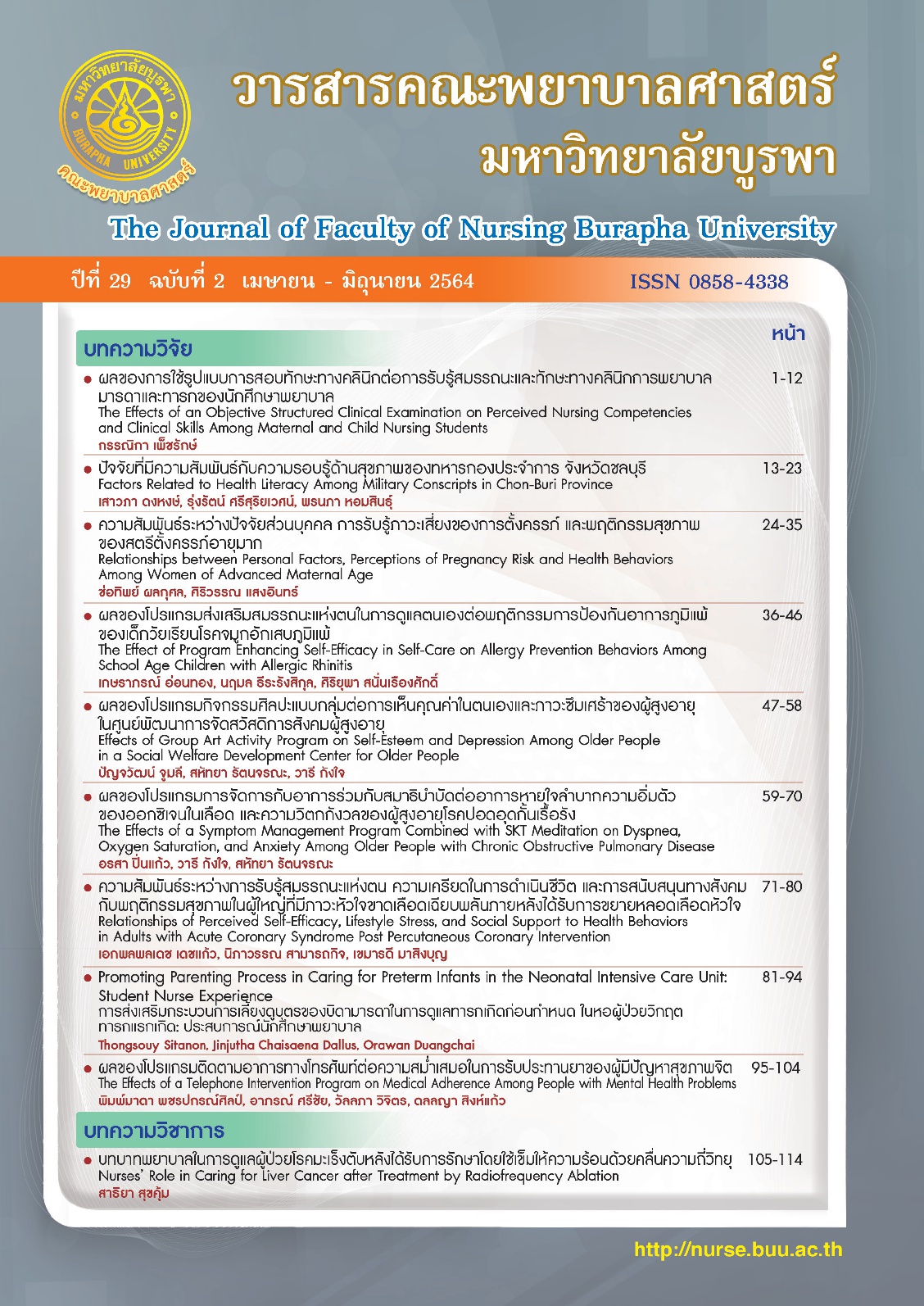บทบาทพยาบาลในการดูแลผู้ป่วยโรคมะเร็งตับหลังได้รับการรักษา โดยใช้เข็มให้ความร้อนด้วยคลื่นความถี่วิทยุ
คำสำคัญ:
โรคมะเร็งตับ, การรักษาโดยใช้เข็มให้ความร้อนด้วยคลื่นถี่วิทยุ, บทบาทการพยาบาลบทคัดย่อ
มะเร็งตับเป็นโรคมะเร็งที่พบได้บ่อยทั่วโลก ข้อมูลประเทศไทยจากสถาบันมะเร็งแห่งชาติ ปี พ.ศ. 2560 พบผู้ป่วย
เป็นโรคมะเร็งตับเป็นอันดับ 2 รองจากมะเร็งเต้านม ส่วนใหญ่พบในวัยกลางคน ปัจจุบันมีแนวทางการรักษาอย่าง
หลากหลายโดยแนวทางส่วนใหญ่จะแยกเป็นกลุ่มที่สามารถผ่าตัดได้และไม่สามารถผ่าตัดได้ ดังนั้นการรักษาด้วยโดยใช้
เข็มให้ความร้อนพิเศษด้วยคลื่นวิทยุ โดยสอดเข็มผ่านทางผิวหนังเข้าไปยังก้อนมะเร็งในตับและให้ความร้อนผ่านเข็มเข้าไป
ทำลายเนื้อเยื่อมะเร็งเป็นการดูแลผู้ป่วยตามมาตรฐาน เพื่อให้เกิดประสิทธิภาพเทียบเคียงการผ่าตัด ซึ่งบทความวิชาการ
นี้จัดทำขึ้นโดยมีวัตถุประสงค์เพื่อให้พยาบาลมีความรู้ความเข้าใจในการดูแลผู้ป่วยโรคมะเร็งตับหลังได้รับการรักษาโดยใช้
เข็มให้ความร้อนด้วยคลื่นความถี่วิทยุ สถานการณ์โรคมะเร็งตับ ปัจจัยเสี่ยงของโรคมะเร็งตับ ลักษณะทางคลินิก ระยะ
ของโรคมะเร็งตับ การวินิจฉัย การรักษาโรคมะเร็งตับ การรักษามะเร็งตับโดยใช้เข็มให้ความร้อนด้วยคลื่นวิทยุ ข้อบ่งชี้
ในการรักษามะเร็งตับโดยวิธี RFA ข้อห้ามหรือข้อจำกัดในการรักษา และบทบาทพยาบาลในการดูแลผู้ป่วยโรคมะเร็งตับ
ที่ได้รับการรักษาโดยใช้เข็มให้ความร้อนด้วยคลื่นความถี่วิทยุแบบองค์รวมครอบคลุมทั้งร่ายกาย จิตใจ อารมณ์ และสังคม
ตั้งแต่ก่อนการรักษา หลังการรักษา และเตรียมตัวผู้ป่วยก่อนกลับบ้าน โดยมีจุดมุ่งหมายเพื่อให้ผู้ป่วยปลอดภัยและมี
คุณภาพชีวิตที่ดีขึ้น
เอกสารอ้างอิง
Audomsan, R. (2002). Nursing care of patients with hepatocellular carcinoma and transarterial oily chemoembolization. Rama Nurse Journal, 8(3), 224-234. [In Thai]
Chaiterakit, R. (2018). Liver and bile duct cancer. Bangkok: Text and Journal Publication. [In Thai]
Cheng, J., Chen, S. L., Zimmerman, N., Dalton, J. E., LaSalle, G., & Rosenquist, R. (2016). A new radiofrequency ablation procedure to treat sacroiliac joint pain. Pain Physician, 19(8), 603-615.
Ding, J., Jing, X., Liu, J., Wang, Y., Wang, F., Wang, Y., Du, Z. (2013). Complications of thermal ablation of hepatic tumors: Comparison of radiofrequency and microwave ablative techniques. Clinical Radiology, 68(6), 608-615.
Doherty, J. U., Gluckman, T. J., Hucker, W. J., Januzzi, J.L., Ortel, T. L., Saxonhouse, S. J., Spinler, S. A. (2017). ACC expert consensus decision pathway for periprocedural management of anticoagulation in patients with nonvalvular atrial fbrillation. Journal of American College of Cardiology, 69(7), 871-898.
Fongchan, S., Vorapongsathorn, S., Bhavabudananda, P., & Chooratna, K. (2019). Liver cancer prevention and control. Thai Cancer Journal, 39(2), 64-74. [In Thai]
Fujiwara, N., Friedman, S. L., Goossens, N., &Hoshida, Y. (2018). Risk factors and prevention of hepatocellular carcinoma in the era of precision medicine. Journal of hepatology, 68(3), 526-549.
International Agency for Research on Cancer. (2020). Thailand source: Globocan 2020. Retrieved 18 May 2021 from https://gco.iarc.fr/today/data/factsheets/populations/764-thailand-fact-sheets.pdf
Lee, D. H., Lee, J. M., Lee, J. Y., Kim, S.H., Yoon, J.H., Kim, J. K., Choi, B. I. (2014) Radiofrequency ablation of hepatocellular carcinoma as frst-line treatment: Long-term results and prognostic factors in 162 patients with cirrhosis. Radiology, 270(3), 900-909.
Mansoori, A. A., & Jain, S. K. (2015). Molecular links between alcohol and tobacco induced DNA damage, gene polymorphisms and patho-physiological consequences: A systematic review of hepatic carcinogenesis. Asian Pac J Cancer Prev, 16(12), 4803-4812.
Meekaew, M. (2018). Effcacy of radiofrequency ablation (RFA) and transarterial chemoembolization (TACE) in the management of unresectable early and intermediate stages of HCC. Journal of the Department of Medical Services, 43(1), 69-73. [In Thai]
National Cancer Institute. (2016). Current concept in management of cholangiocarcinoma. Bangkok: Offce of National buddhism Press. [In Thai]
National Cancer Institute. (2019). Hospital-based cancer registry 2019. Bangkok: NewThaammada Press (Thailand) Co., Ltd. [In Thai]
Ratna, A. & Mandrekar, P. (2017). Alcohol and cancer: Mechanisms and therapies. Biomolecules, 7(3), 61.
Sangdit B. (2015). Hepatocellula carcinoma prevention and control measures inThailand. Royal Thai Army Medical Journal, 68(4), 193-201. [In Thai]
Thai Association for the Study of the Liver. (2019). Thailand guideline for management of hepatocellular carcinoma. Nontaburi:Parbpim limited partnership. [In Thai]
Watanakit, N., Adulpatcharaporn, S., & Petchkongkaew, A. (2014). Microorganism to degrade the bioavailability of aflatoxin B1. Naresuan University Journal: Science And Technology, 22(2), 1-11. [In Thai]
Yongmanitchai, C. (2014). Handle hepatocellular carcinoma and keep it under control. Bangkok: Inspire Printing. [In Thai]





